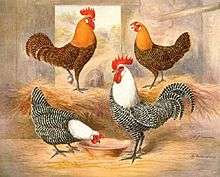Campine (chicken)
 Silver and Gold varieties of the Campine | |
| Conservation status | RBST (UK): at risk[1] |
|---|---|
| Country of origin | Belgium |
| Use | eggs, show |
| Traits | |
| Weight |
Male: Standard: 2.7 kg Bantam: 680 g[2]:89 |
|
Female: Standard: 2.3 kg Bantam: 570 g[2]:89 | |
| Egg color | white |
| Comb type | single |
| Classification | |
| APA | continental[3] |
| ABA | single comb clean legged |
| PCGB | rare soft feather: light[4] |
|
Chicken Gallus gallus domesticus | |

The Campine is a breed of domestic chicken originating in the northern part of Belgium. It is named for the Campine region of north-eastern Belgium and south-eastern Netherlands. It was known there as the Kempisch Hoen.
History
The Campine was originally a smaller type of the Braekel, weighing up to 1.2 kg less.[5] It was distributed throughout the province of Antwerp and in the northern and central part of the province of Limbourg. It was decided in 1884 that the two types should be separated.[6] After a long controversy, the Campine became a separate breed with its own breed standard on 28 August 1904. After further controversy, the two breeds were reunited under a single standard in 1925[5] or 1926,[6] with the name Kempisch-Braekel.[5] In 1962 it was decided that the Campine type had entirely disappeared, and the name of the Belgian breed was changed to Brakelhoen.[5]
The Campine was imported to England in about 1899, and was bred there to become a very different bird. In particular, hen feathering in cocks became standard. Hen-feathered Braekel cocks had been bred by Oscar Thomaes of Ronse, Belgium, in 1904,[5] and a cock hatched from one of his eggs took first place at a show at the Alexandra Palace in London in that year.[7]
Birds were exported from Britain to the United States. A Campines cock took first prizes at Madison Square Garden, New York City, and in Boston in January 1913.[7] The Campines was added to the Standard of Perfection of the American Poultry Association in 1914.[3]
Characteristics
There are two colour varieties of the Campine, Silver and Gold. Both sexes have the same colour pattern: the Silver has a pure white head and neck hackles, the rest of the bird being barred with beetle-green on a pure white ground; the Golden variety has the same pattern, but the head, neck hackles and body ground colour is rich gold rather than white. [2]:87 Campines are considered to be a flighty, hardy breed with an active and inquisitive nature. They are among the rarest of domestic chicken breeds.
Use
The Campine lays a fair number of white-shelled eggs, but is kept mostly for showing today.
Genetic research
The Golden Campine was used in early research into auto-sexing in chickens by Reginald Crundall Punnett and Michael Pease at the Genetical Institute in Cambridge. The Cambar, the first auto-sexing hybrid, created in 1929, was a cross between the Golden Campine and the Barred Rock.[2]:53[8][9][10]
The hen-feathering trait in cocks of the Golden Campine has been found to be identical to that in the Sebright, a bantam breed. It has been suggested that it is the same gene, and that the trait in the Campine derives from the Sebright.[11][12][13]
The Campine is closely related to the Dutch Chaamse Hoen,[2]:86 and also to the Fayoumi.
See also
References
- ↑ Native Poultry Breeds at Risk. Rare Breeds Survival Trust. Accessed August 2014.
- 1 2 3 4 5 Victoria Roberts (2008). British poultry standards: complete specifications and judging points of all standardized breeds and varieties of poultry as compiled by the specialist breed clubs and recognised by the Poultry Club of Great Britain. Oxford: Blackwell. ISBN 9781405156424.
- 1 2 APA Recognized Breeds and Varieties as of January 1, 2012. American Poultry Association. Accessed August 2014.
- ↑ Breed Classification. Poultry Club of Great Britain. Accessed August 2014.
- 1 2 3 4 5 Het Brakelhoen (in Dutch). Lierde: Braekelclub-Nederbraekel. Accessed August 2014.
- 1 2 N. Moula, M. Jacquet, A. Verelst, N. Antoine-Moussiaux, F. Farnir, P. Leroy (2012). Les races de poules belges (in French). Annales de Médecine Vétérinaire 156: 37-65. Accessed August 2014.
- 1 2 Frank L. Platt ([1914]). The Campines, silver and golden; their history; their practical qualities; how to mate and breed them; how to judge them; the Campine standards of America, England and Belgium. Quincy, Illinois: Reliable Poultry Journal Publishing Company; Buffalo, New York: American Poultry Publishing Company. doi:10.5962/bhl.title.57005
- ↑ F.A.E. Crew (1967). Reginald Crundall Punnett. 1875-1967. Biographical Memoirs of Fellows of the Royal Society 13: 309-326. (subscription required)
- ↑ Francis H.A. Marshall, Edward Thomas Halnan (1946 [1920]). Physiology of farm animals, fourth edition. Cambridge: The University Press. p. 270–71.
- ↑ Chris Graham (2006). Choosing and Keeping Chickens. London: Hamlyn. ISBN 9780600614388. p. 150–51.
- ↑ F.W. George, H. Matsumine, M. J. McPhaul, R. G. Somes, Jr., and J. D. Wilson (1990). Inheritance of the Henny Feathering Trait in the Golden Campine Chicken: Evidence for Allelism with the Gene That Causes Henny Feathering in the Sebright Bantam. Journal of Heredity 81 (2): 107-110. (subscription required)
- ↑ 107910: Cytochrome P450, family 19, subfamily A, polypeptide 1; CYP19A1. Online Mendelian Inheritance in Man, McKusick-Nathans Institute of Genetic Medicine, Johns Hopkins University School of Medicine. Accessed August 2014.
- ↑ Victor Almon McKusik (1998). Mendelian inheritance in man: catalog of human genes and genetic disorders, Volume 2. JHU Press.